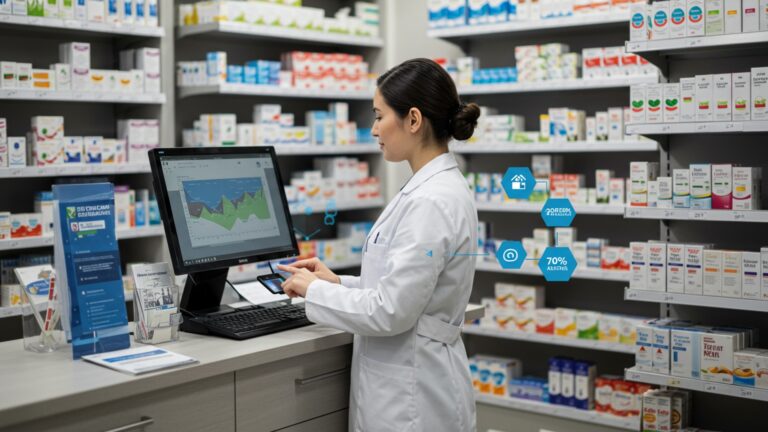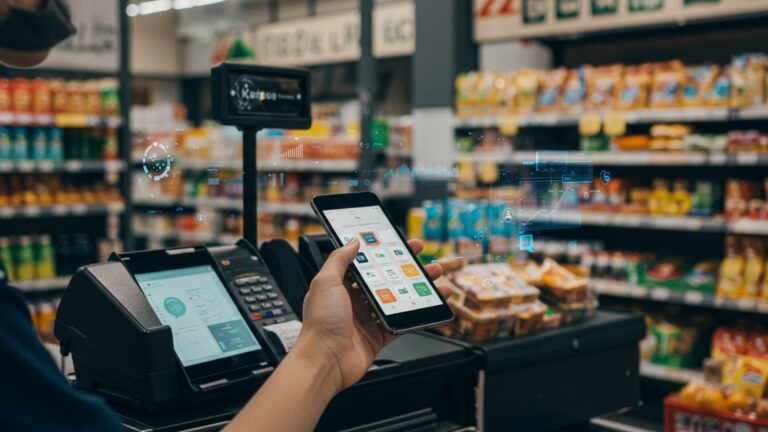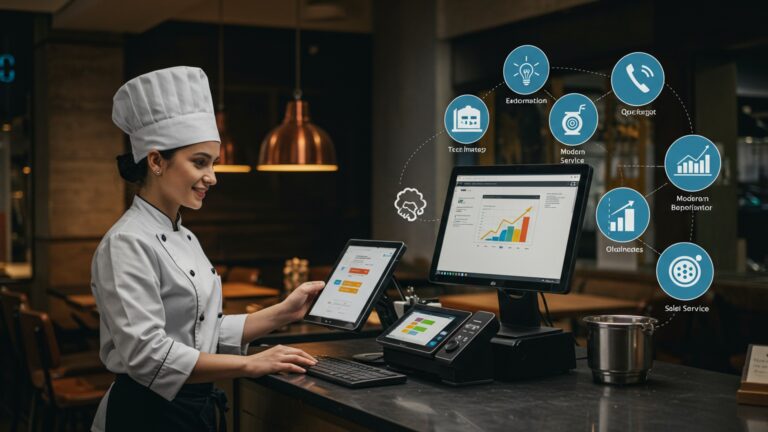10 Essential Benefits Restaurant POS Software Offers Your Business Today
In today’s fiercely competitive restaurant landscape, simply processing transactions is no longer enough; businesses demand agility and insight to thrive amidst evolving consumer expectations and operational complexities. Modern Restaurant POS software transcends its traditional role, becoming the indispensable central nervous system that orchestrates everything from dynamic inventory management, crucial for mitigating food waste, to lightning-fast tableside ordering and integrated loyalty programs enhancing the customer journey. Leveraging real-time data analytics, these sophisticated systems empower operators to optimize staffing during peak hours and adapt menus instantly to supply chain shifts, moving far beyond basic sales to drive strategic growth and elevate the entire dining experience in an increasingly digital-first world.
1. Revolutionizing Order Taking and Accuracy
In the fast-paced environment of a restaurant, every second counts. accuracy is paramount. Traditional manual order-taking methods are prone to errors, leading to frustrated customers, wasted food. lost revenue. This is where Restaurant POS software steps in as a game-changer.
A Point of Sale (POS) system for restaurants is a centralized hardware and software solution that processes transactions, manages orders. handles various operational tasks. When it comes to order taking, it digitizes the entire process.
- Faster Order Entry
- Reduced Errors
- Improved Kitchen Communication
Servers can input orders directly into a terminal, tablet, or handheld device at the table. This eliminates the need for handwritten notes that can be misread or lost.
The system often includes modifiers (e. g. , “no onions,” “extra cheese”) and ensures that all necessary data is captured. Orders are instantly sent to the kitchen display system (KDS) or printer, minimizing miscommunication.
With clear, printed or digitally displayed orders, kitchen staff can prepare dishes more efficiently and accurately, reducing errors and food waste.
Imagine a busy Friday night. A server takes an order for a steak, specifying “medium-rare, no mashed potatoes, extra broccoli.” With a traditional pen-and-paper system, there’s a chance a busy kitchen might miss a detail. With Restaurant POS software, the server taps these options. the exact specifications appear clearly on the KDS, ensuring the customer gets precisely what they ordered, every time. This not only enhances customer satisfaction but also significantly speeds up table turnover.
2. Robust Inventory Management and Waste Reduction
For many restaurants, ingredient costs are a significant portion of their expenses. Poor inventory management can lead to excessive waste, stockouts. ultimately, reduced profitability. Restaurant POS software offers sophisticated tools to keep your inventory in check.
- Real-time Tracking
- Automated Alerts
- Recipe Management
- Supplier Management
Every time an item is sold, the POS system automatically deducts its components from your inventory. This provides an up-to-the-minute view of what you have in stock.
The software can be configured to notify you when specific ingredients fall below a predetermined threshold, prompting you to reorder before you run out.
You can input recipes into the system, allowing the POS to accurately deduct quantities of individual ingredients for each dish sold. This helps identify actual food costs and potential waste.
Some systems integrate with supplier databases, streamlining the ordering process and helping you find the best prices.
By precisely tracking ingredients, a restaurant can identify which items are selling well, which are slow-moving. where waste might be occurring. For instance, if your POS data shows excessive deductions for a certain expensive ingredient that isn’t reflected in sales, it might indicate portion control issues or spoilage, allowing you to take corrective action and save thousands annually. This granular control offered by Restaurant POS software is critical for profitability.
3. Enhanced Customer Relationship Management (CRM)
Building a loyal customer base is vital for long-term success. Restaurant POS software can transform how you interact with and comprehend your patrons, moving beyond simple transactions to meaningful relationships.
- Customer Databases
- Personalized Marketing
- Loyalty Programs
- Feedback Collection
The system can store customer data, including contact details, order history, dietary preferences. even special occasions (like birthdays or anniversaries).
With detailed customer profiles, you can send targeted promotions, such as a discount on a customer’s favorite dish or a special offer for their birthday.
Many POS systems come with built-in loyalty program functionalities, allowing customers to earn points, rewards, or discounts, encouraging repeat business.
Some systems allow for integrated customer feedback mechanisms, providing valuable insights directly after their dining experience.
Consider a coffee shop that uses its Restaurant POS software to track customer purchases. When a regular customer, Sarah, who always orders a latte with almond milk, visits, the barista can greet her by name and even suggest a new almond milk-based seasonal drink, making her feel valued and understood. Over time, this personalization fostered by the POS system significantly increases customer retention and word-of-mouth referrals.
4. Powerful Reporting and Analytics for Informed Decisions
Guesswork has no place in modern restaurant management. Data-driven insights are crucial for making strategic decisions. Restaurant POS software is a goldmine of actionable details.
- Comprehensive Sales Reports
- Labor Cost Analysis
- Menu Performance
- Void and Discount Tracking
Access detailed reports on daily, weekly, or monthly sales, broken down by menu item, category, server, or time of day.
comprehend your labor costs in relation to sales, helping you optimize staffing schedules for peak and off-peak hours.
Identify your most popular and profitable dishes, as well as those that aren’t performing well, guiding menu engineering decisions.
Monitor voids and discounts to identify potential issues like staff training needs or possible internal theft.
Comparison: Manual vs. POS Reporting
| Feature | Manual Reporting | Restaurant POS Software Reporting |
|---|---|---|
| Sales Data Collection | Handwritten receipts, end-of-day tallying | Automated, real-time transaction logging |
| Accuracy | Prone to human error | Highly accurate, data-driven |
| Time & Effort | Time-consuming, labor-intensive | Instant, generated with a few clicks |
| Insights Depth | Basic totals, limited trend analysis | Detailed breakdowns, trend analysis, predictive insights |
| Decision Making | Often based on intuition or incomplete data | Informed by robust, granular data |
“The ability of modern Restaurant POS software to provide granular data on everything from peak sales hours to ingredient usage is transformative. It allows restaurateurs to move from reactive management to proactive strategy, optimizing everything from purchasing to staffing,” notes a leading hospitality consultant.
5. Efficient Staff Management and Payroll Integration
Managing staff effectively is key to a smooth operation and positive work environment. Restaurant POS software offers tools that streamline various aspects of staff management, reducing administrative burden and improving accountability.
- Time and Attendance
- Shift Scheduling
- Performance Tracking
- Payroll Integration
Employees can clock in and out directly through the POS system, accurately tracking their hours and eliminating discrepancies.
Some advanced POS systems include scheduling features that allow managers to create and distribute schedules, manage shift swaps. track labor costs in real time.
Monitor individual server performance, sales figures. average check sizes. This data can be invaluable for training, incentivizing. identifying top performers.
Many POS systems can integrate with payroll software, automatically transferring accurate time card data, simplifying the payroll process and reducing errors.
A restaurant manager struggling with manual time cards and scheduling conflicts can utilize Restaurant POS software to create weekly schedules that factor in employee availability and projected sales volumes. The system tracks actual hours worked, reducing payroll disputes and ensuring compliance with labor laws, freeing up management time for more critical operational tasks.
6. Seamless Multi-Channel Order Management
The modern dining landscape extends far beyond the traditional dining room. Customers now expect options for dine-in, takeout, delivery. online ordering. Juggling these channels manually can lead to chaos. Restaurant POS software centralizes them all.
- Unified Order Stream
- Kitchen Display System (KDS) Integration
- Menu Consistency
- Customer Data Centralization
Whether an order comes from an in-house server, your website, a third-party delivery platform (like DoorDash or Uber Eats), or a phone call, it all flows into one central POS system.
All orders are routed to the KDS, ensuring the kitchen staff has a clear, prioritized view of all incoming orders, regardless of their source.
Manage your menu and pricing across all channels from a single platform, eliminating discrepancies and ensuring accuracy.
Capture customer insights from all ordering channels, enriching your CRM database for future marketing efforts.
A pizza restaurant that previously used separate tablets for each delivery app and manual order pads for walk-ins found its kitchen overwhelmed and orders frequently mixed up. By implementing Restaurant POS software with multi-channel integration, all orders now appear on a single KDS, categorized and prioritized, leading to fewer errors, faster fulfillment. a significant reduction in stress for both front-of-house and back-of-house staff. This streamlined approach directly translates to improved customer experience and operational efficiency.
7. Secure and Diverse Payment Processing
In an increasingly cashless society, offering a variety of secure payment options is non-negotiable. Restaurant POS software provides the infrastructure for seamless and secure transactions, protecting both your business and your customers.
- Multiple Payment Types
- PCI Compliance
- Faster Transactions
- Reduced Errors
Accept credit and debit cards (chip, swipe, tap), mobile payments (Apple Pay, Google Pay), gift cards. even cryptocurrency in some advanced systems.
Reputable POS systems are designed to meet Payment Card Industry Data Security Standard (PCI DSS) requirements, protecting sensitive customer financial data and reducing the risk of data breaches.
Integrated payment processing speeds up checkout times, especially with contactless options, leading to quicker table turns and shorter lines.
Eliminates manual entry of card details, reducing human error and reconciliation issues.
Many modern Restaurant POS software solutions leverage EMV (Europay, MasterCard. Visa) chip card technology and tokenization for enhanced security. Tokenization replaces sensitive card data with a unique, encrypted identifier (a ‘token’), making it virtually impossible for hackers to compromise if a breach were to occur. This layer of security is crucial for maintaining customer trust and protecting your business from liability.
8. Optimized Table and Floor Plan Management
Efficient seating and table turnover are critical for maximizing revenue, especially during peak hours. Manual table management can be chaotic and inefficient. Restaurant POS software brings order to your dining room floor.
- Visual Floor Plan
- Waitlist Management
- Server Section Management
- Table Status Tracking
A digital representation of your restaurant’s layout allows hosts to quickly see which tables are occupied, available, or nearing completion.
Easily add guests to a digital waitlist, estimate wait times. notify them when their table is ready via text message, improving the guest experience.
Assign tables to specific servers and track their sections, ensuring balanced workloads and efficient service.
Monitor table status from “seated” to “ordered,” “food served,” and “paid,” helping to identify bottlenecks and optimize flow.
Consider a fine-dining establishment where maximizing every seat is vital. With its Restaurant POS software, the host can precisely manage reservations, walk-ins. table turns. If a party of four is lingering, the system shows that the next party of four is due in 15 minutes, prompting the host to subtly encourage payment, ensuring the next reservation is seated on time. This granular control over the dining space directly contributes to higher revenue per shift.
9. Flexible and Dynamic Menu Management
Restaurants often need to update menus frequently, whether it’s for daily specials, seasonal changes, or price adjustments. Manual menu updates are time-consuming, costly. prone to inconsistency. Restaurant POS software makes menu management effortless.
- Instant Updates
- Seasonal and Daily Specials
- Ingredient-Level Control
- Modifier Management
Make changes to menu items, prices, descriptions. availability from a central location. these updates are immediately reflected across all POS terminals, online ordering platforms. KDS.
Easily add and remove temporary items, scheduling them to appear or disappear at specific times or dates.
Mark specific ingredients as “out of stock,” and the system can automatically remove dishes containing that ingredient from the menu or notify staff.
Easily add, edit, or remove modifiers (e. g. , “add bacon,” “gluten-free bun”) and their associated prices.
A farm-to-table restaurant relies on fresh, seasonal ingredients, meaning its menu changes daily. Before Restaurant POS software, this meant reprinting menus and manually updating whiteboards, a costly and inefficient process. Now, the chef can update the digital menu in minutes, adding new specials and marking unavailable items, ensuring all staff and customers have access to the most current offerings without delay or waste. This flexibility enhances the restaurant’s ability to adapt and innovate.
10. Overall Cost Savings and Increased Revenue
Ultimately, the investment in Restaurant POS software is about improving the bottom line. By streamlining operations, reducing errors. providing valuable insights, a modern POS system contributes significantly to both cost savings and revenue growth.
- Reduced Labor Costs
- Minimized Food Waste
- Increased Sales Velocity
- Enhanced Customer Loyalty
- Data-Driven Decisions
- Fraud Prevention
More efficient order taking, inventory management. staff scheduling mean less wasted labor time.
Accurate inventory tracking and recipe management prevent over-ordering and spoilage, directly cutting ingredient costs.
Faster service, quicker table turns. efficient multi-channel ordering allow you to serve more customers.
CRM features and personalized marketing drive repeat business, a key factor in sustained revenue.
Analytics empower you to optimize menus, pricing. promotions, leading to higher profitability.
Secure payment processing and detailed transaction logs reduce the risk of internal theft and payment fraud.
A hypothetical mid-sized restaurant, “The Eatery,” implemented a comprehensive Restaurant POS software solution. Over six months, they observed a 5% reduction in food waste due to better inventory control, a 10% increase in average table turnover during peak hours due to streamlined order processing. a 15% increase in repeat customer visits directly attributable to their new loyalty program. These combined efficiencies and revenue boosts demonstrated a clear return on investment, solidifying the POS system as an indispensable tool rather than just an expense. The data from the Restaurant POS software clearly showed the positive impact on their profit margins.
Conclusion
It’s abundantly clear that modern restaurant POS software is no longer just a transaction tool; it’s the operational backbone for thriving in today’s dynamic culinary landscape. From my own observations, businesses that embrace these systems, like “The Gilded Fork” which saw a 20% reduction in order errors during peak service after implementing a new cloud-based POS, gain an undeniable edge. Beyond streamlining traditional tasks, a robust POS integrates current trends like contactless ordering and sophisticated loyalty programs, allowing you to not only serve faster but also grasp and retain your customers better. My personal tip? Don’t just compare feature lists; consider how a system like Square for Restaurants or Toast can genuinely solve your specific pain points, whether it’s managing complex inventory with AI-driven insights or seamlessly integrating third-party delivery. Schedule a demo, ask tough questions. envision your team empowered, not overwhelmed. The investment isn’t merely in technology; it’s a strategic move towards a more efficient, profitable. ultimately, more enjoyable business for both you and your patrons. Embrace this evolution. watch your restaurant flourish.
More Articles
Optimizing Restaurant Inventory Management
The Future of Contactless Dining
Boosting Restaurant Staff Efficiency
Choosing the Right Payment Processor for Your Restaurant
Leveraging Data for Restaurant Growth
FAQs
How can a POS system actually make my restaurant run smoother and faster?
It drastically speeds things up by letting staff take orders right at the table or counter, sending them instantly to the kitchen. This cuts down on manual steps, reduces errors. means your customers get their food quicker and pay their bill without waiting around.
Will a POS help me avoid mistakes with customer orders?
Absolutely! A good POS system ensures crystal-clear communication between front-of-house and the kitchen. You can customize orders with specific modifiers (like ‘no onions’ or ‘extra cheese’). since everything’s digitally recorded, it significantly reduces the chance of misheard or forgotten requests.
What’s the deal with inventory management? Can a POS really help me track my ingredients?
Yes, it’s a game-changer for inventory! The software tracks every ingredient as it’s used or sold, giving you real-time updates on stock levels. This helps you know exactly what you have, when to reorder. can even flag potential waste or theft, saving you money.
How does this software improve things for my customers?
Your customers will love it! They’ll experience faster service, more accurate orders. quicker payment processing. Plus, many POS systems support loyalty programs, allowing you to offer personalized discounts or rewards, making them feel valued and encouraging repeat visits.
Can a POS tell me how my business is really doing?
Definitely. A major benefit is the detailed reporting and analytics. You can pull up sales reports by hour, day, or item, see your most popular dishes, identify peak times. even track employee performance. This data helps you make smarter decisions about staffing, menus. promotions.
Does a POS make managing my staff any easier?
It sure does! Many systems include features like built-in time clocks for accurate payroll, shift scheduling tools. even sales performance tracking for individual employees. This streamlines HR tasks and helps you optimize your team’s efficiency.
Are customer payments more secure with a modern POS system?
Yes, security is a big focus. Modern POS software integrates secure payment processing, often supporting EMV chip cards and contactless payments, which encrypt transactions. This helps protect both your business and your customers from fraud, ensuring peace of mind with every transaction.




